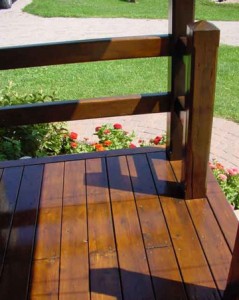Canadians love decks, and while those built to code are perfectly safe, it’s always wise to keep your eyes open for warning signs. Everything eventually deteriorates, and no one else is going to monitor the state of your deck for you.In general, there are two sources of possible danger:
- Weakened deck structures that arise from rot or foundation shifting
- Failure of the connection between a deck and the building to which it’s fastened.
Rotten Deck Floorboards
 Fortunately, the most likely source of deck trouble is also the easiest to spot: a rotten floor. All wood, even pressure-treated lumber and cedar, eventually rots. It’s just a matter of time. And while it’s not always easy to see rot underneath a ground-level deck, it’s always worth looking everywhere you can, beginning on top.
Fortunately, the most likely source of deck trouble is also the easiest to spot: a rotten floor. All wood, even pressure-treated lumber and cedar, eventually rots. It’s just a matter of time. And while it’s not always easy to see rot underneath a ground-level deck, it’s always worth looking everywhere you can, beginning on top.
- Floorboards are one of the most rot-prone areas of any wooden deck because water lies on the planks after rains.
- Moisture is also often trapped underneath, where the floor boards rest on their supporting joists. And this last fact — the issue of trapped moisture — is a valuable piece of information in the hunt for rot in other places.
- Wherever two or more pieces of wood touch, the potential for rot is higher because moisture is retained.
- Add to this the fact that insects love to leave nutrient-rich droppings in tight wood-to-wood gaps, and you’ve got all the ingredients needed for decay.
By the time you see rot on a floorboard, beam or post, the damage is always more extensive than it appears. That’s why you’ve got to resist the temptation to ignore warning signs. Look deep.
- Visible rot is just the tail end of a process where mold and fungus organisms sink root-like structures into the wood, extracting nutrients and leaving behind weakened cells.
- If you can see rot, it’s time to get out an old pocketknife and start poking around. Any wood that you can push into deeper than 1/8-inch with moderate pressure, is probably too weak to function as designed.
- Replacement of rotten deck components is a possibility, since not all parts of a deck go bad at the same rate. That said, don’t get too stingy. It makes no sense to replace bad floorboards over joists that aren’t much better.
Deck Support Systems
Most decks are built on top of two kinds of support systems:
- Vertical posts or piers that hold up the outer edges and ends of the structure.
- Some kind of connection to the outside wall of the building that the deck adjoins.
The option of bolting a deck to a wall is almost always used because it saves time and money by making use of the existing support offered by the building. Trouble is, if the deck-to-house connection isn’t sound, it can result in a sudden collapse of the deck under heavy loads. While a rotten deck board might let your leg collapse into a hole after months of spongy warnings, a connection failure can let the whole thing fall down in a heartbeat, tilting in towards the house as it does. And while the potential loss from collapse increases as deck height goes up (the higher you are, the harder you fall), it’s also easier to inspect the deck-to-house connection on tall decks.
- Besides looking for rot that’s invaded the wood bolted to your house, you also need to look at the wall itself and the bolts or lag screws used to secure the deck.
- If you spot flaking masonry, loose or angled anchored bolts, or evidence that the deck has sunk lower down the wall from it’s original construction height (even a little), it’s time to call in a professional.
- The fix might just involve adding more bolts, adding support posts next to the wall to take some of the load, or deck reconstruction if rot is a serious problem.
The bottom line in all this is simple: enjoy your deck, but be diligent. Life is never without risk, but a few minute’s attention are all you need to whittle your deck top worries down to size. And after you’ve done that, your biggest deck concern shouldn’t be anything more taxing than what to put on the barbecue this weekend.



